Financial Analysis Report: The Unite Group plc Performance
VerifiedAdded on 2021/02/19
|14
|3059
|32
Report
AI Summary
This report provides a comprehensive financial analysis of The Unite Group plc, a leading student accommodation provider in the UK. It begins with an introduction to financial reporting and its importance, followed by a detailed calculation of various financial ratios, including profitability, liquidity, efficiency, and gearing ratios, for the years 2017 and 2018. The report then evaluates the company's performance and financial position based on these ratios, highlighting trends and improvements. Furthermore, the report analyzes the changes in lease accounting rules from IAS 17 to IFRS 16, discussing their implications. The analysis covers key financial metrics like net profit margin, current ratio, quick ratio, and debt-to-equity ratio. The conclusion summarizes the key findings, and the report includes references and an appendix for further information. The report emphasizes the company's financial health and strategic decisions based on the financial statements, including improvements in profitability, liquidity, and a shift in debt management.
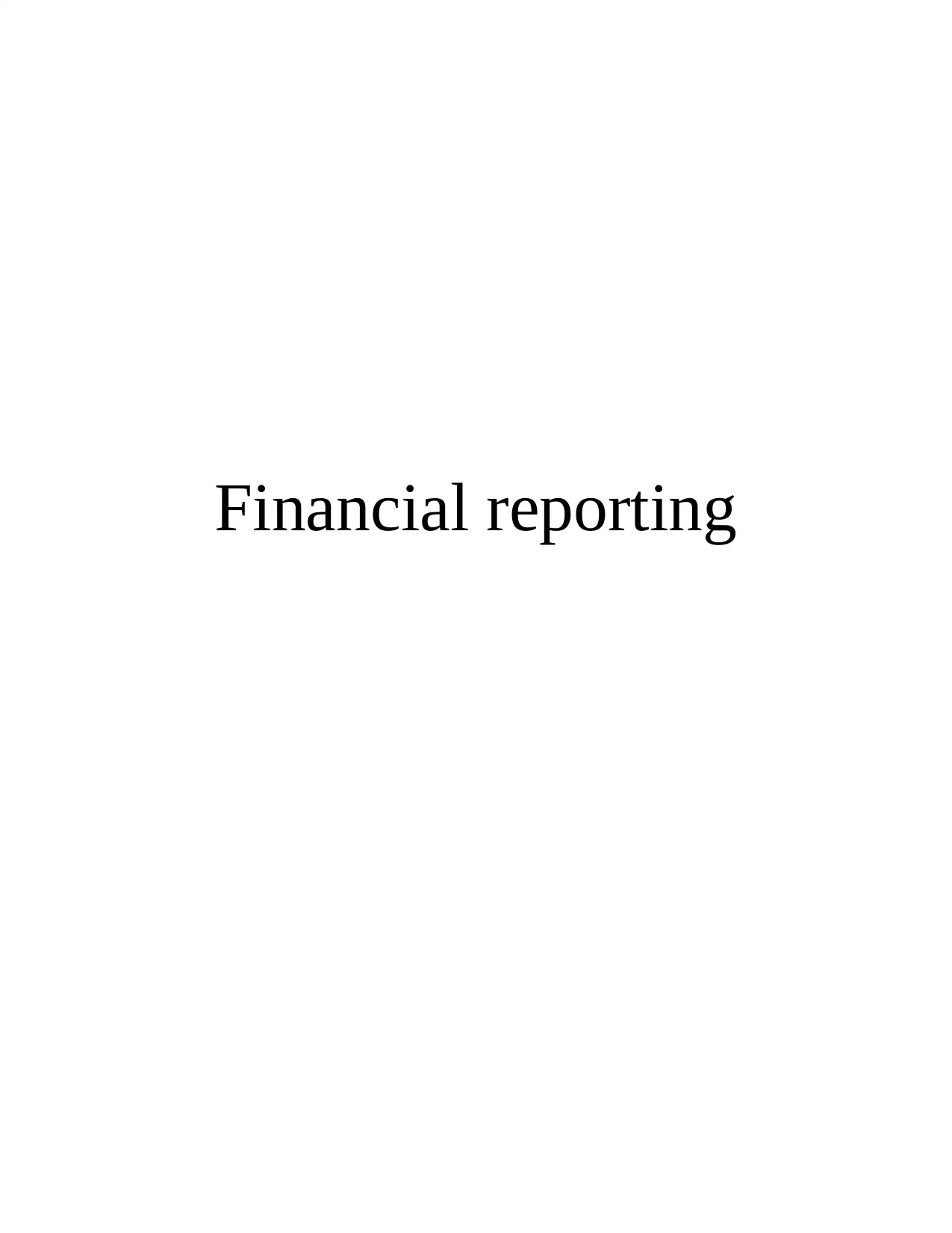
Financial reporting
Paraphrase This Document
Need a fresh take? Get an instant paraphrase of this document with our AI Paraphraser
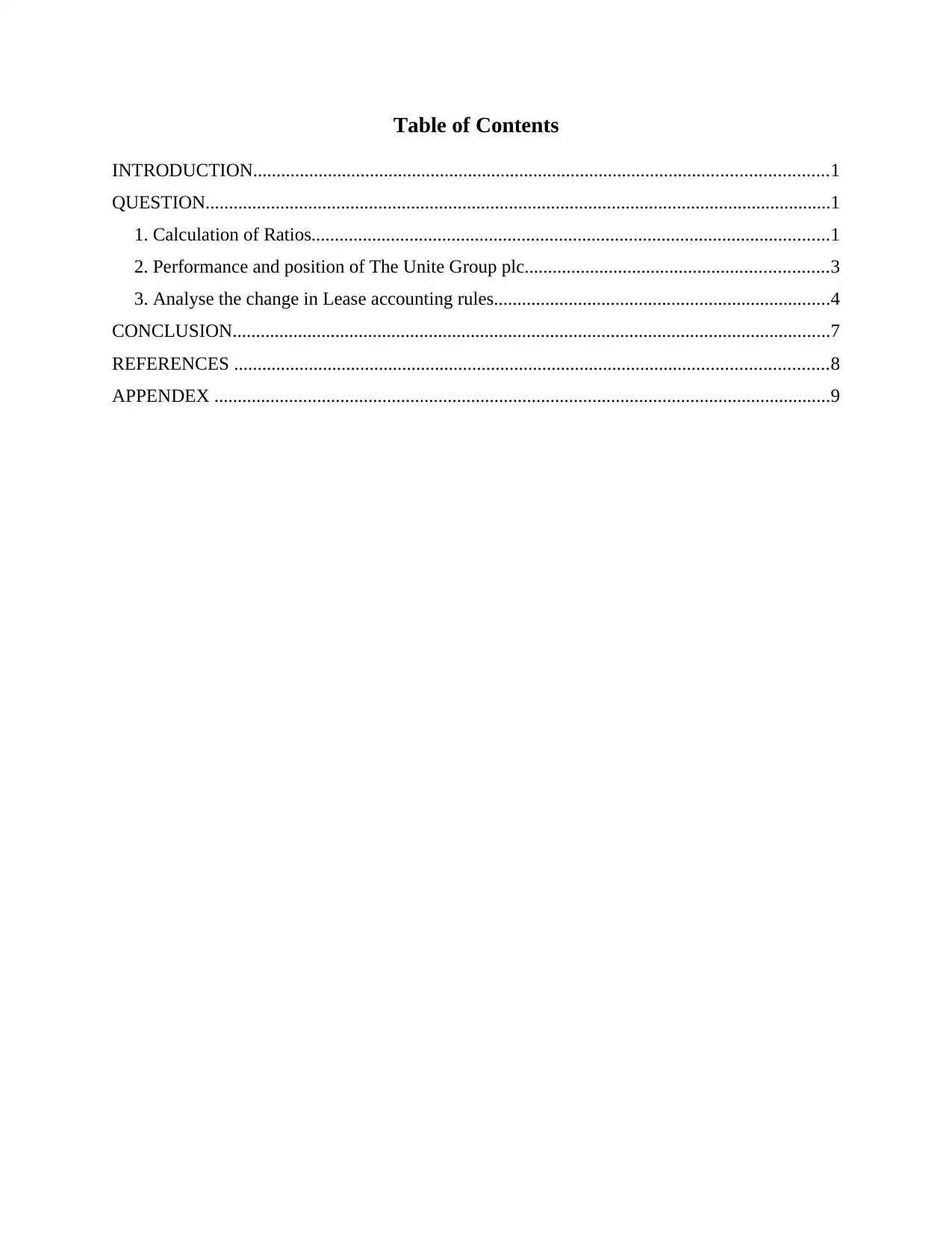
Table of Contents
INTRODUCTION...........................................................................................................................1
QUESTION......................................................................................................................................1
1. Calculation of Ratios...............................................................................................................1
2. Performance and position of The Unite Group plc.................................................................3
3. Analyse the change in Lease accounting rules........................................................................4
CONCLUSION................................................................................................................................7
REFERENCES ...............................................................................................................................8
APPENDEX ....................................................................................................................................9
INTRODUCTION...........................................................................................................................1
QUESTION......................................................................................................................................1
1. Calculation of Ratios...............................................................................................................1
2. Performance and position of The Unite Group plc.................................................................3
3. Analyse the change in Lease accounting rules........................................................................4
CONCLUSION................................................................................................................................7
REFERENCES ...............................................................................................................................8
APPENDEX ....................................................................................................................................9
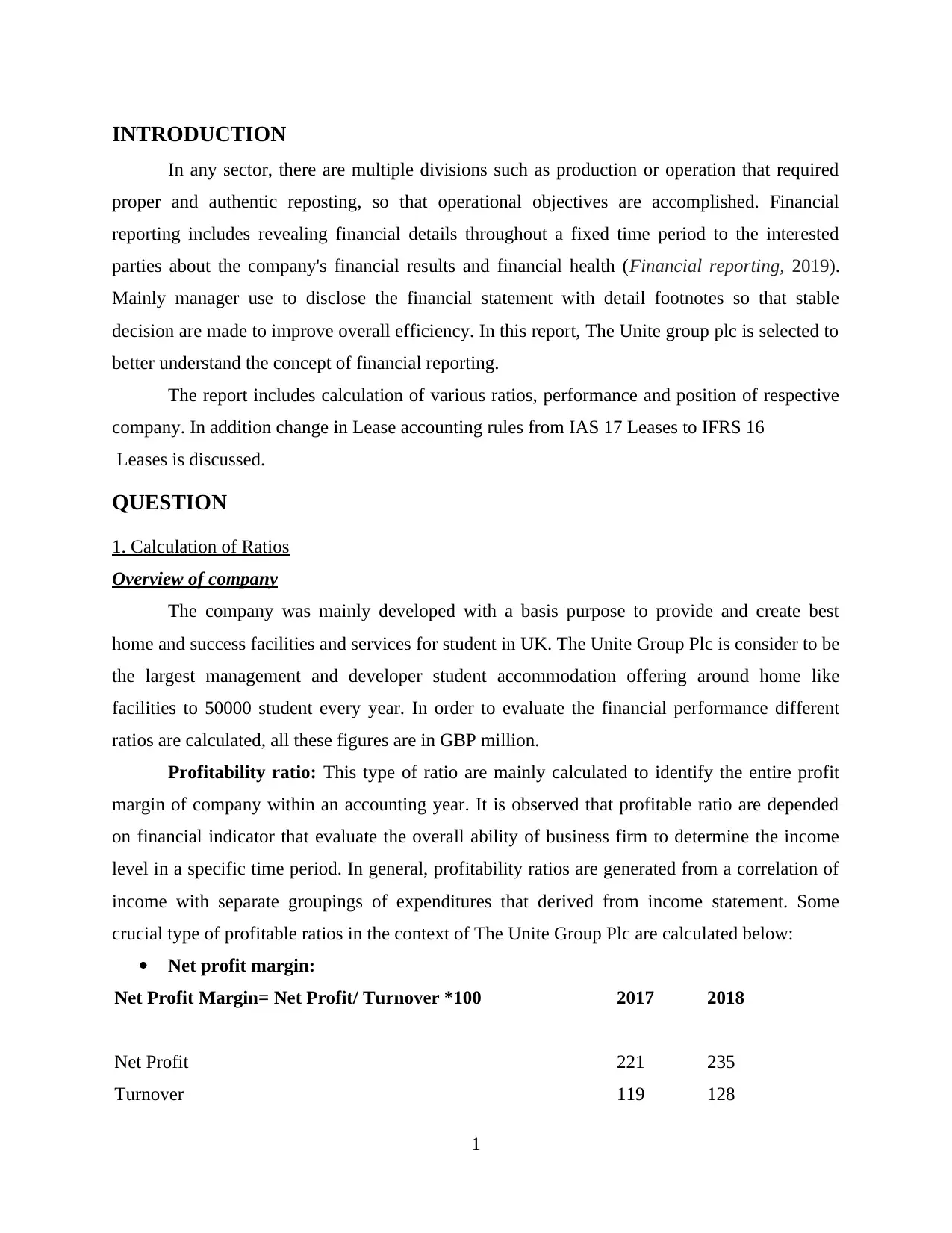
INTRODUCTION
In any sector, there are multiple divisions such as production or operation that required
proper and authentic reposting, so that operational objectives are accomplished. Financial
reporting includes revealing financial details throughout a fixed time period to the interested
parties about the company's financial results and financial health (Financial reporting, 2019).
Mainly manager use to disclose the financial statement with detail footnotes so that stable
decision are made to improve overall efficiency. In this report, The Unite group plc is selected to
better understand the concept of financial reporting.
The report includes calculation of various ratios, performance and position of respective
company. In addition change in Lease accounting rules from IAS 17 Leases to IFRS 16
Leases is discussed.
QUESTION
1. Calculation of Ratios
Overview of company
The company was mainly developed with a basis purpose to provide and create best
home and success facilities and services for student in UK. The Unite Group Plc is consider to be
the largest management and developer student accommodation offering around home like
facilities to 50000 student every year. In order to evaluate the financial performance different
ratios are calculated, all these figures are in GBP million.
Profitability ratio: This type of ratio are mainly calculated to identify the entire profit
margin of company within an accounting year. It is observed that profitable ratio are depended
on financial indicator that evaluate the overall ability of business firm to determine the income
level in a specific time period. In general, profitability ratios are generated from a correlation of
income with separate groupings of expenditures that derived from income statement. Some
crucial type of profitable ratios in the context of The Unite Group Plc are calculated below:
Net profit margin:
Net Profit Margin= Net Profit/ Turnover *100 2017 2018
Net Profit 221 235
Turnover 119 128
1
In any sector, there are multiple divisions such as production or operation that required
proper and authentic reposting, so that operational objectives are accomplished. Financial
reporting includes revealing financial details throughout a fixed time period to the interested
parties about the company's financial results and financial health (Financial reporting, 2019).
Mainly manager use to disclose the financial statement with detail footnotes so that stable
decision are made to improve overall efficiency. In this report, The Unite group plc is selected to
better understand the concept of financial reporting.
The report includes calculation of various ratios, performance and position of respective
company. In addition change in Lease accounting rules from IAS 17 Leases to IFRS 16
Leases is discussed.
QUESTION
1. Calculation of Ratios
Overview of company
The company was mainly developed with a basis purpose to provide and create best
home and success facilities and services for student in UK. The Unite Group Plc is consider to be
the largest management and developer student accommodation offering around home like
facilities to 50000 student every year. In order to evaluate the financial performance different
ratios are calculated, all these figures are in GBP million.
Profitability ratio: This type of ratio are mainly calculated to identify the entire profit
margin of company within an accounting year. It is observed that profitable ratio are depended
on financial indicator that evaluate the overall ability of business firm to determine the income
level in a specific time period. In general, profitability ratios are generated from a correlation of
income with separate groupings of expenditures that derived from income statement. Some
crucial type of profitable ratios in the context of The Unite Group Plc are calculated below:
Net profit margin:
Net Profit Margin= Net Profit/ Turnover *100 2017 2018
Net Profit 221 235
Turnover 119 128
1
⊘ This is a preview!⊘
Do you want full access?
Subscribe today to unlock all pages.

Trusted by 1+ million students worldwide
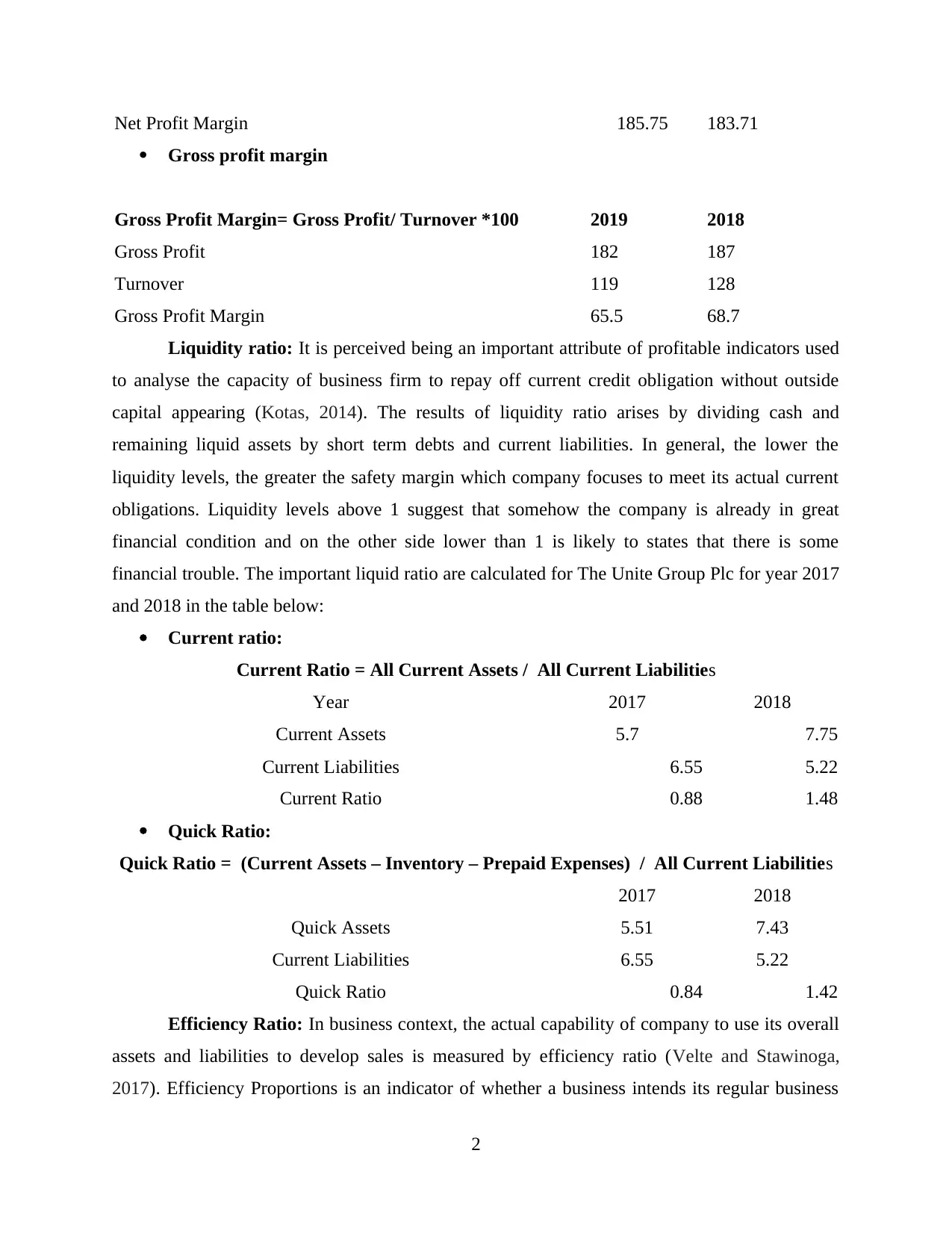
Net Profit Margin 185.75 183.71
Gross profit margin
Gross Profit Margin= Gross Profit/ Turnover *100 2019 2018
Gross Profit 182 187
Turnover 119 128
Gross Profit Margin 65.5 68.7
Liquidity ratio: It is perceived being an important attribute of profitable indicators used
to analyse the capacity of business firm to repay off current credit obligation without outside
capital appearing (Kotas, 2014). The results of liquidity ratio arises by dividing cash and
remaining liquid assets by short term debts and current liabilities. In general, the lower the
liquidity levels, the greater the safety margin which company focuses to meet its actual current
obligations. Liquidity levels above 1 suggest that somehow the company is already in great
financial condition and on the other side lower than 1 is likely to states that there is some
financial trouble. The important liquid ratio are calculated for The Unite Group Plc for year 2017
and 2018 in the table below:
Current ratio:
Current Ratio = All Current Assets / All Current Liabilities
Year 2017 2018
Current Assets 5.7 7.75
Current Liabilities 6.55 5.22
Current Ratio 0.88 1.48
Quick Ratio:
Quick Ratio = (Current Assets – Inventory – Prepaid Expenses) / All Current Liabilities
2017 2018
Quick Assets 5.51 7.43
Current Liabilities 6.55 5.22
Quick Ratio 0.84 1.42
Efficiency Ratio: In business context, the actual capability of company to use its overall
assets and liabilities to develop sales is measured by efficiency ratio (Velte and Stawinoga,
2017). Efficiency Proportions is an indicator of whether a business intends its regular business
2
Gross profit margin
Gross Profit Margin= Gross Profit/ Turnover *100 2019 2018
Gross Profit 182 187
Turnover 119 128
Gross Profit Margin 65.5 68.7
Liquidity ratio: It is perceived being an important attribute of profitable indicators used
to analyse the capacity of business firm to repay off current credit obligation without outside
capital appearing (Kotas, 2014). The results of liquidity ratio arises by dividing cash and
remaining liquid assets by short term debts and current liabilities. In general, the lower the
liquidity levels, the greater the safety margin which company focuses to meet its actual current
obligations. Liquidity levels above 1 suggest that somehow the company is already in great
financial condition and on the other side lower than 1 is likely to states that there is some
financial trouble. The important liquid ratio are calculated for The Unite Group Plc for year 2017
and 2018 in the table below:
Current ratio:
Current Ratio = All Current Assets / All Current Liabilities
Year 2017 2018
Current Assets 5.7 7.75
Current Liabilities 6.55 5.22
Current Ratio 0.88 1.48
Quick Ratio:
Quick Ratio = (Current Assets – Inventory – Prepaid Expenses) / All Current Liabilities
2017 2018
Quick Assets 5.51 7.43
Current Liabilities 6.55 5.22
Quick Ratio 0.84 1.42
Efficiency Ratio: In business context, the actual capability of company to use its overall
assets and liabilities to develop sales is measured by efficiency ratio (Velte and Stawinoga,
2017). Efficiency Proportions is an indicator of whether a business intends its regular business
2
Paraphrase This Document
Need a fresh take? Get an instant paraphrase of this document with our AI Paraphraser
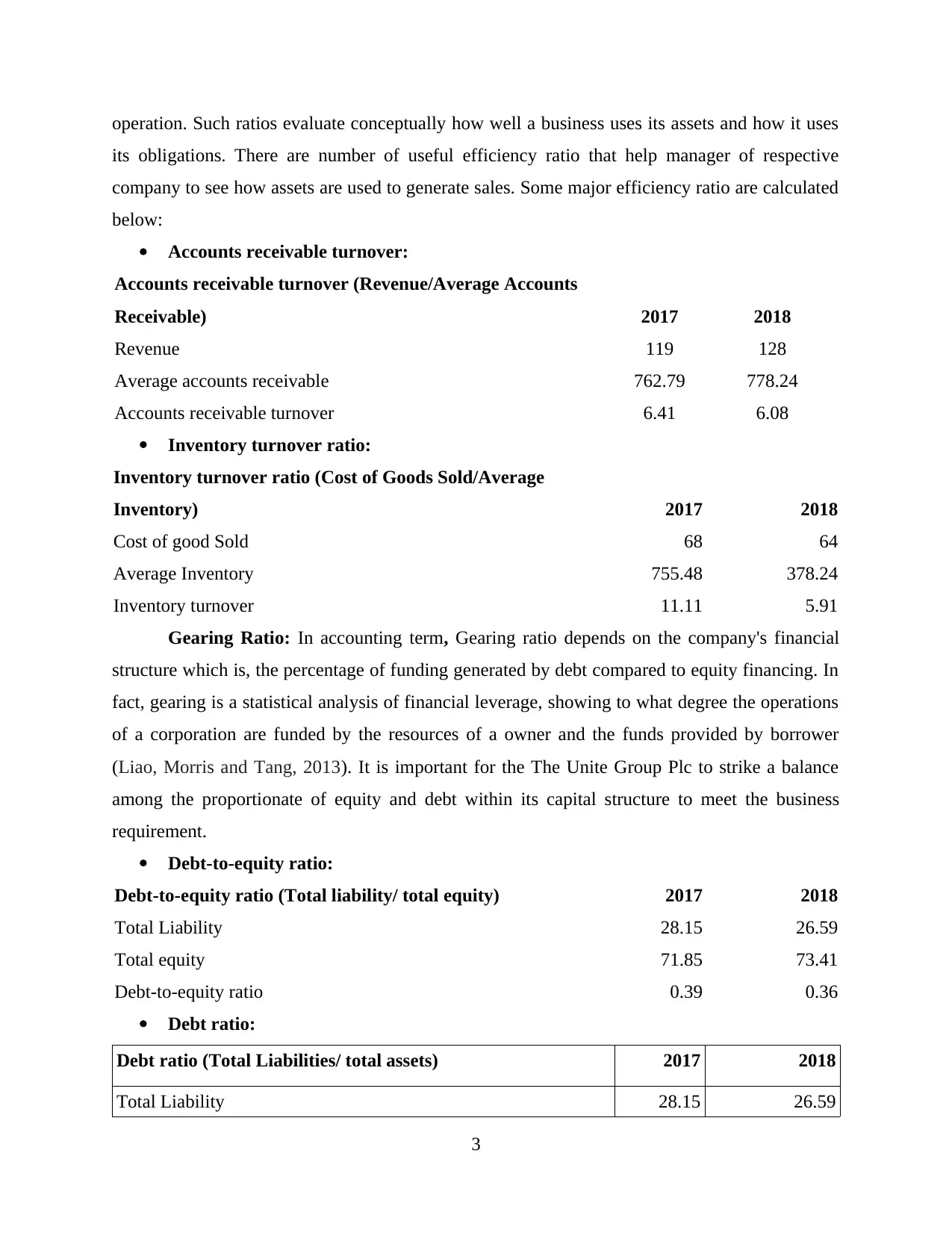
operation. Such ratios evaluate conceptually how well a business uses its assets and how it uses
its obligations. There are number of useful efficiency ratio that help manager of respective
company to see how assets are used to generate sales. Some major efficiency ratio are calculated
below:
Accounts receivable turnover:
Accounts receivable turnover (Revenue/Average Accounts
Receivable) 2017 2018
Revenue 119 128
Average accounts receivable 762.79 778.24
Accounts receivable turnover 6.41 6.08
Inventory turnover ratio:
Inventory turnover ratio (Cost of Goods Sold/Average
Inventory) 2017 2018
Cost of good Sold 68 64
Average Inventory 755.48 378.24
Inventory turnover 11.11 5.91
Gearing Ratio: In accounting term, Gearing ratio depends on the company's financial
structure which is, the percentage of funding generated by debt compared to equity financing. In
fact, gearing is a statistical analysis of financial leverage, showing to what degree the operations
of a corporation are funded by the resources of a owner and the funds provided by borrower
(Liao, Morris and Tang, 2013). It is important for the The Unite Group Plc to strike a balance
among the proportionate of equity and debt within its capital structure to meet the business
requirement.
Debt-to-equity ratio:
Debt-to-equity ratio (Total liability/ total equity) 2017 2018
Total Liability 28.15 26.59
Total equity 71.85 73.41
Debt-to-equity ratio 0.39 0.36
Debt ratio:
Debt ratio (Total Liabilities/ total assets) 2017 2018
Total Liability 28.15 26.59
3
its obligations. There are number of useful efficiency ratio that help manager of respective
company to see how assets are used to generate sales. Some major efficiency ratio are calculated
below:
Accounts receivable turnover:
Accounts receivable turnover (Revenue/Average Accounts
Receivable) 2017 2018
Revenue 119 128
Average accounts receivable 762.79 778.24
Accounts receivable turnover 6.41 6.08
Inventory turnover ratio:
Inventory turnover ratio (Cost of Goods Sold/Average
Inventory) 2017 2018
Cost of good Sold 68 64
Average Inventory 755.48 378.24
Inventory turnover 11.11 5.91
Gearing Ratio: In accounting term, Gearing ratio depends on the company's financial
structure which is, the percentage of funding generated by debt compared to equity financing. In
fact, gearing is a statistical analysis of financial leverage, showing to what degree the operations
of a corporation are funded by the resources of a owner and the funds provided by borrower
(Liao, Morris and Tang, 2013). It is important for the The Unite Group Plc to strike a balance
among the proportionate of equity and debt within its capital structure to meet the business
requirement.
Debt-to-equity ratio:
Debt-to-equity ratio (Total liability/ total equity) 2017 2018
Total Liability 28.15 26.59
Total equity 71.85 73.41
Debt-to-equity ratio 0.39 0.36
Debt ratio:
Debt ratio (Total Liabilities/ total assets) 2017 2018
Total Liability 28.15 26.59
3
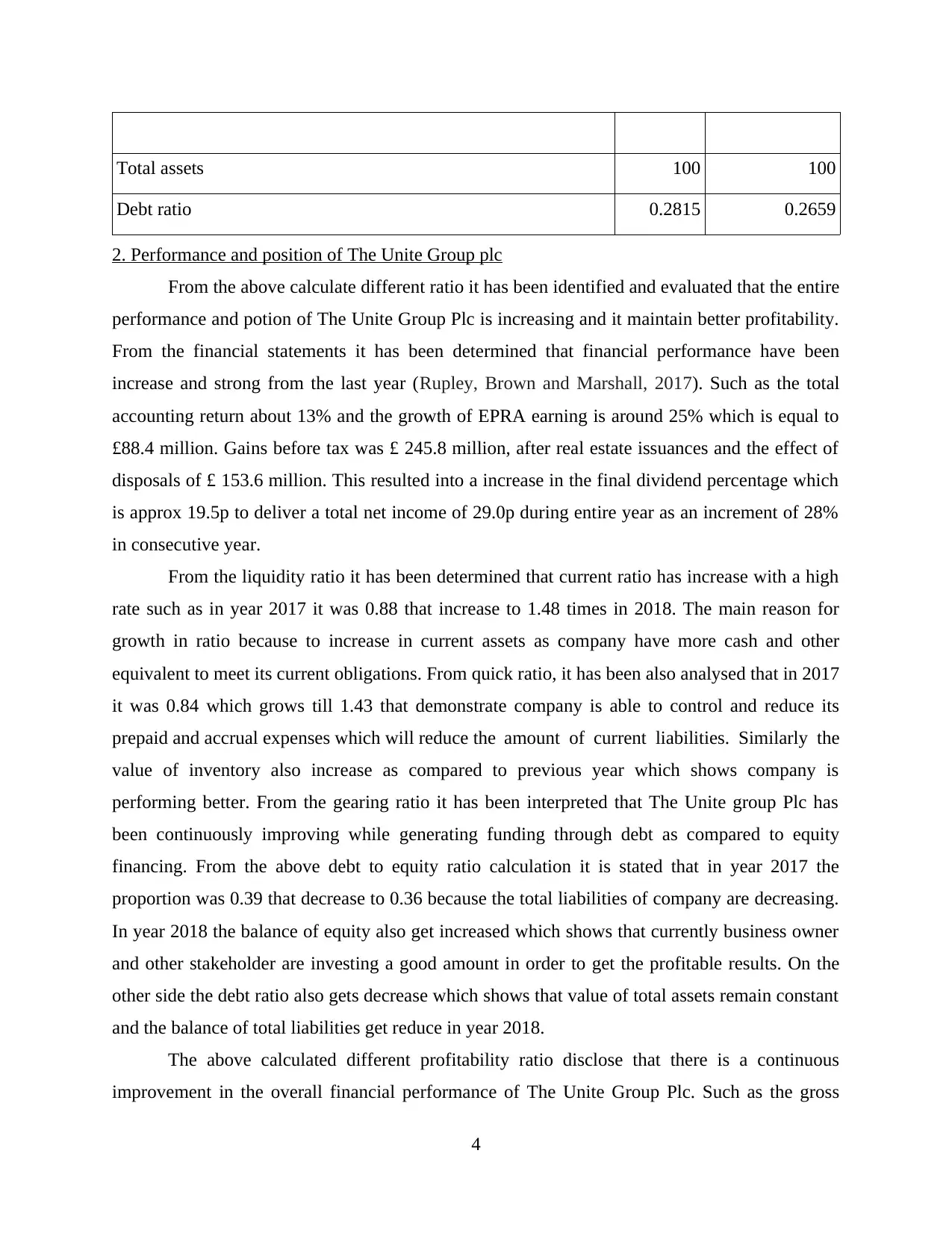
Total assets 100 100
Debt ratio 0.2815 0.2659
2. Performance and position of The Unite Group plc
From the above calculate different ratio it has been identified and evaluated that the entire
performance and potion of The Unite Group Plc is increasing and it maintain better profitability.
From the financial statements it has been determined that financial performance have been
increase and strong from the last year (Rupley, Brown and Marshall, 2017). Such as the total
accounting return about 13% and the growth of EPRA earning is around 25% which is equal to
£88.4 million. Gains before tax was £ 245.8 million, after real estate issuances and the effect of
disposals of £ 153.6 million. This resulted into a increase in the final dividend percentage which
is approx 19.5p to deliver a total net income of 29.0p during entire year as an increment of 28%
in consecutive year.
From the liquidity ratio it has been determined that current ratio has increase with a high
rate such as in year 2017 it was 0.88 that increase to 1.48 times in 2018. The main reason for
growth in ratio because to increase in current assets as company have more cash and other
equivalent to meet its current obligations. From quick ratio, it has been also analysed that in 2017
it was 0.84 which grows till 1.43 that demonstrate company is able to control and reduce its
prepaid and accrual expenses which will reduce the amount of current liabilities. Similarly the
value of inventory also increase as compared to previous year which shows company is
performing better. From the gearing ratio it has been interpreted that The Unite group Plc has
been continuously improving while generating funding through debt as compared to equity
financing. From the above debt to equity ratio calculation it is stated that in year 2017 the
proportion was 0.39 that decrease to 0.36 because the total liabilities of company are decreasing.
In year 2018 the balance of equity also get increased which shows that currently business owner
and other stakeholder are investing a good amount in order to get the profitable results. On the
other side the debt ratio also gets decrease which shows that value of total assets remain constant
and the balance of total liabilities get reduce in year 2018.
The above calculated different profitability ratio disclose that there is a continuous
improvement in the overall financial performance of The Unite Group Plc. Such as the gross
4
Debt ratio 0.2815 0.2659
2. Performance and position of The Unite Group plc
From the above calculate different ratio it has been identified and evaluated that the entire
performance and potion of The Unite Group Plc is increasing and it maintain better profitability.
From the financial statements it has been determined that financial performance have been
increase and strong from the last year (Rupley, Brown and Marshall, 2017). Such as the total
accounting return about 13% and the growth of EPRA earning is around 25% which is equal to
£88.4 million. Gains before tax was £ 245.8 million, after real estate issuances and the effect of
disposals of £ 153.6 million. This resulted into a increase in the final dividend percentage which
is approx 19.5p to deliver a total net income of 29.0p during entire year as an increment of 28%
in consecutive year.
From the liquidity ratio it has been determined that current ratio has increase with a high
rate such as in year 2017 it was 0.88 that increase to 1.48 times in 2018. The main reason for
growth in ratio because to increase in current assets as company have more cash and other
equivalent to meet its current obligations. From quick ratio, it has been also analysed that in 2017
it was 0.84 which grows till 1.43 that demonstrate company is able to control and reduce its
prepaid and accrual expenses which will reduce the amount of current liabilities. Similarly the
value of inventory also increase as compared to previous year which shows company is
performing better. From the gearing ratio it has been interpreted that The Unite group Plc has
been continuously improving while generating funding through debt as compared to equity
financing. From the above debt to equity ratio calculation it is stated that in year 2017 the
proportion was 0.39 that decrease to 0.36 because the total liabilities of company are decreasing.
In year 2018 the balance of equity also get increased which shows that currently business owner
and other stakeholder are investing a good amount in order to get the profitable results. On the
other side the debt ratio also gets decrease which shows that value of total assets remain constant
and the balance of total liabilities get reduce in year 2018.
The above calculated different profitability ratio disclose that there is a continuous
improvement in the overall financial performance of The Unite Group Plc. Such as the gross
4
⊘ This is a preview!⊘
Do you want full access?
Subscribe today to unlock all pages.

Trusted by 1+ million students worldwide
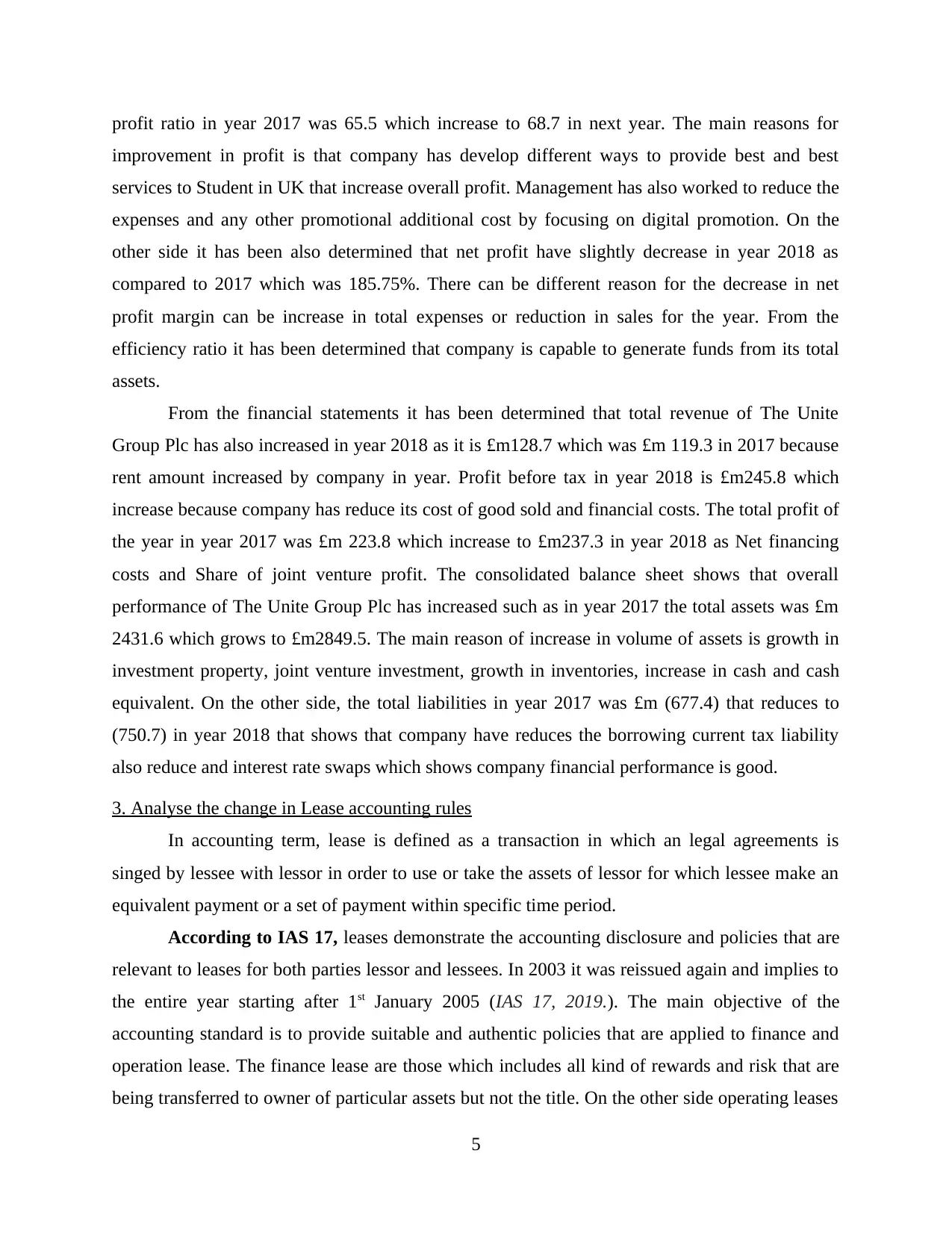
profit ratio in year 2017 was 65.5 which increase to 68.7 in next year. The main reasons for
improvement in profit is that company has develop different ways to provide best and best
services to Student in UK that increase overall profit. Management has also worked to reduce the
expenses and any other promotional additional cost by focusing on digital promotion. On the
other side it has been also determined that net profit have slightly decrease in year 2018 as
compared to 2017 which was 185.75%. There can be different reason for the decrease in net
profit margin can be increase in total expenses or reduction in sales for the year. From the
efficiency ratio it has been determined that company is capable to generate funds from its total
assets.
From the financial statements it has been determined that total revenue of The Unite
Group Plc has also increased in year 2018 as it is £m128.7 which was £m 119.3 in 2017 because
rent amount increased by company in year. Profit before tax in year 2018 is £m245.8 which
increase because company has reduce its cost of good sold and financial costs. The total profit of
the year in year 2017 was £m 223.8 which increase to £m237.3 in year 2018 as Net financing
costs and Share of joint venture profit. The consolidated balance sheet shows that overall
performance of The Unite Group Plc has increased such as in year 2017 the total assets was £m
2431.6 which grows to £m2849.5. The main reason of increase in volume of assets is growth in
investment property, joint venture investment, growth in inventories, increase in cash and cash
equivalent. On the other side, the total liabilities in year 2017 was £m (677.4) that reduces to
(750.7) in year 2018 that shows that company have reduces the borrowing current tax liability
also reduce and interest rate swaps which shows company financial performance is good.
3. Analyse the change in Lease accounting rules
In accounting term, lease is defined as a transaction in which an legal agreements is
singed by lessee with lessor in order to use or take the assets of lessor for which lessee make an
equivalent payment or a set of payment within specific time period.
According to IAS 17, leases demonstrate the accounting disclosure and policies that are
relevant to leases for both parties lessor and lessees. In 2003 it was reissued again and implies to
the entire year starting after 1st January 2005 (IAS 17, 2019.). The main objective of the
accounting standard is to provide suitable and authentic policies that are applied to finance and
operation lease. The finance lease are those which includes all kind of rewards and risk that are
being transferred to owner of particular assets but not the title. On the other side operating leases
5
improvement in profit is that company has develop different ways to provide best and best
services to Student in UK that increase overall profit. Management has also worked to reduce the
expenses and any other promotional additional cost by focusing on digital promotion. On the
other side it has been also determined that net profit have slightly decrease in year 2018 as
compared to 2017 which was 185.75%. There can be different reason for the decrease in net
profit margin can be increase in total expenses or reduction in sales for the year. From the
efficiency ratio it has been determined that company is capable to generate funds from its total
assets.
From the financial statements it has been determined that total revenue of The Unite
Group Plc has also increased in year 2018 as it is £m128.7 which was £m 119.3 in 2017 because
rent amount increased by company in year. Profit before tax in year 2018 is £m245.8 which
increase because company has reduce its cost of good sold and financial costs. The total profit of
the year in year 2017 was £m 223.8 which increase to £m237.3 in year 2018 as Net financing
costs and Share of joint venture profit. The consolidated balance sheet shows that overall
performance of The Unite Group Plc has increased such as in year 2017 the total assets was £m
2431.6 which grows to £m2849.5. The main reason of increase in volume of assets is growth in
investment property, joint venture investment, growth in inventories, increase in cash and cash
equivalent. On the other side, the total liabilities in year 2017 was £m (677.4) that reduces to
(750.7) in year 2018 that shows that company have reduces the borrowing current tax liability
also reduce and interest rate swaps which shows company financial performance is good.
3. Analyse the change in Lease accounting rules
In accounting term, lease is defined as a transaction in which an legal agreements is
singed by lessee with lessor in order to use or take the assets of lessor for which lessee make an
equivalent payment or a set of payment within specific time period.
According to IAS 17, leases demonstrate the accounting disclosure and policies that are
relevant to leases for both parties lessor and lessees. In 2003 it was reissued again and implies to
the entire year starting after 1st January 2005 (IAS 17, 2019.). The main objective of the
accounting standard is to provide suitable and authentic policies that are applied to finance and
operation lease. The finance lease are those which includes all kind of rewards and risk that are
being transferred to owner of particular assets but not the title. On the other side operating leases
5
Paraphrase This Document
Need a fresh take? Get an instant paraphrase of this document with our AI Paraphraser
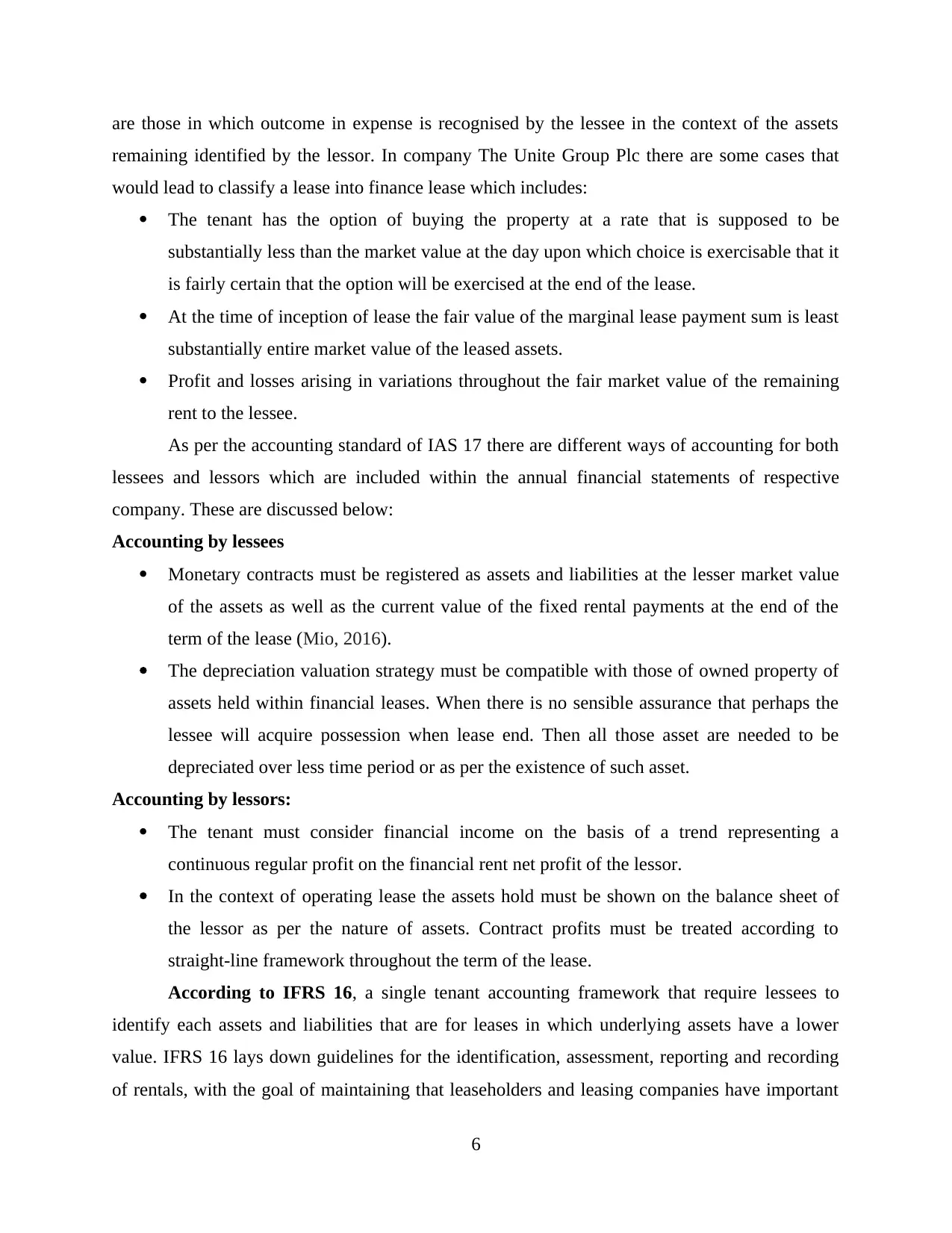
are those in which outcome in expense is recognised by the lessee in the context of the assets
remaining identified by the lessor. In company The Unite Group Plc there are some cases that
would lead to classify a lease into finance lease which includes:
The tenant has the option of buying the property at a rate that is supposed to be
substantially less than the market value at the day upon which choice is exercisable that it
is fairly certain that the option will be exercised at the end of the lease.
At the time of inception of lease the fair value of the marginal lease payment sum is least
substantially entire market value of the leased assets.
Profit and losses arising in variations throughout the fair market value of the remaining
rent to the lessee.
As per the accounting standard of IAS 17 there are different ways of accounting for both
lessees and lessors which are included within the annual financial statements of respective
company. These are discussed below:
Accounting by lessees
Monetary contracts must be registered as assets and liabilities at the lesser market value
of the assets as well as the current value of the fixed rental payments at the end of the
term of the lease (Mio, 2016).
The depreciation valuation strategy must be compatible with those of owned property of
assets held within financial leases. When there is no sensible assurance that perhaps the
lessee will acquire possession when lease end. Then all those asset are needed to be
depreciated over less time period or as per the existence of such asset.
Accounting by lessors:
The tenant must consider financial income on the basis of a trend representing a
continuous regular profit on the financial rent net profit of the lessor.
In the context of operating lease the assets hold must be shown on the balance sheet of
the lessor as per the nature of assets. Contract profits must be treated according to
straight-line framework throughout the term of the lease.
According to IFRS 16, a single tenant accounting framework that require lessees to
identify each assets and liabilities that are for leases in which underlying assets have a lower
value. IFRS 16 lays down guidelines for the identification, assessment, reporting and recording
of rentals, with the goal of maintaining that leaseholders and leasing companies have important
6
remaining identified by the lessor. In company The Unite Group Plc there are some cases that
would lead to classify a lease into finance lease which includes:
The tenant has the option of buying the property at a rate that is supposed to be
substantially less than the market value at the day upon which choice is exercisable that it
is fairly certain that the option will be exercised at the end of the lease.
At the time of inception of lease the fair value of the marginal lease payment sum is least
substantially entire market value of the leased assets.
Profit and losses arising in variations throughout the fair market value of the remaining
rent to the lessee.
As per the accounting standard of IAS 17 there are different ways of accounting for both
lessees and lessors which are included within the annual financial statements of respective
company. These are discussed below:
Accounting by lessees
Monetary contracts must be registered as assets and liabilities at the lesser market value
of the assets as well as the current value of the fixed rental payments at the end of the
term of the lease (Mio, 2016).
The depreciation valuation strategy must be compatible with those of owned property of
assets held within financial leases. When there is no sensible assurance that perhaps the
lessee will acquire possession when lease end. Then all those asset are needed to be
depreciated over less time period or as per the existence of such asset.
Accounting by lessors:
The tenant must consider financial income on the basis of a trend representing a
continuous regular profit on the financial rent net profit of the lessor.
In the context of operating lease the assets hold must be shown on the balance sheet of
the lessor as per the nature of assets. Contract profits must be treated according to
straight-line framework throughout the term of the lease.
According to IFRS 16, a single tenant accounting framework that require lessees to
identify each assets and liabilities that are for leases in which underlying assets have a lower
value. IFRS 16 lays down guidelines for the identification, assessment, reporting and recording
of rentals, with the goal of maintaining that leaseholders and leasing companies have important
6
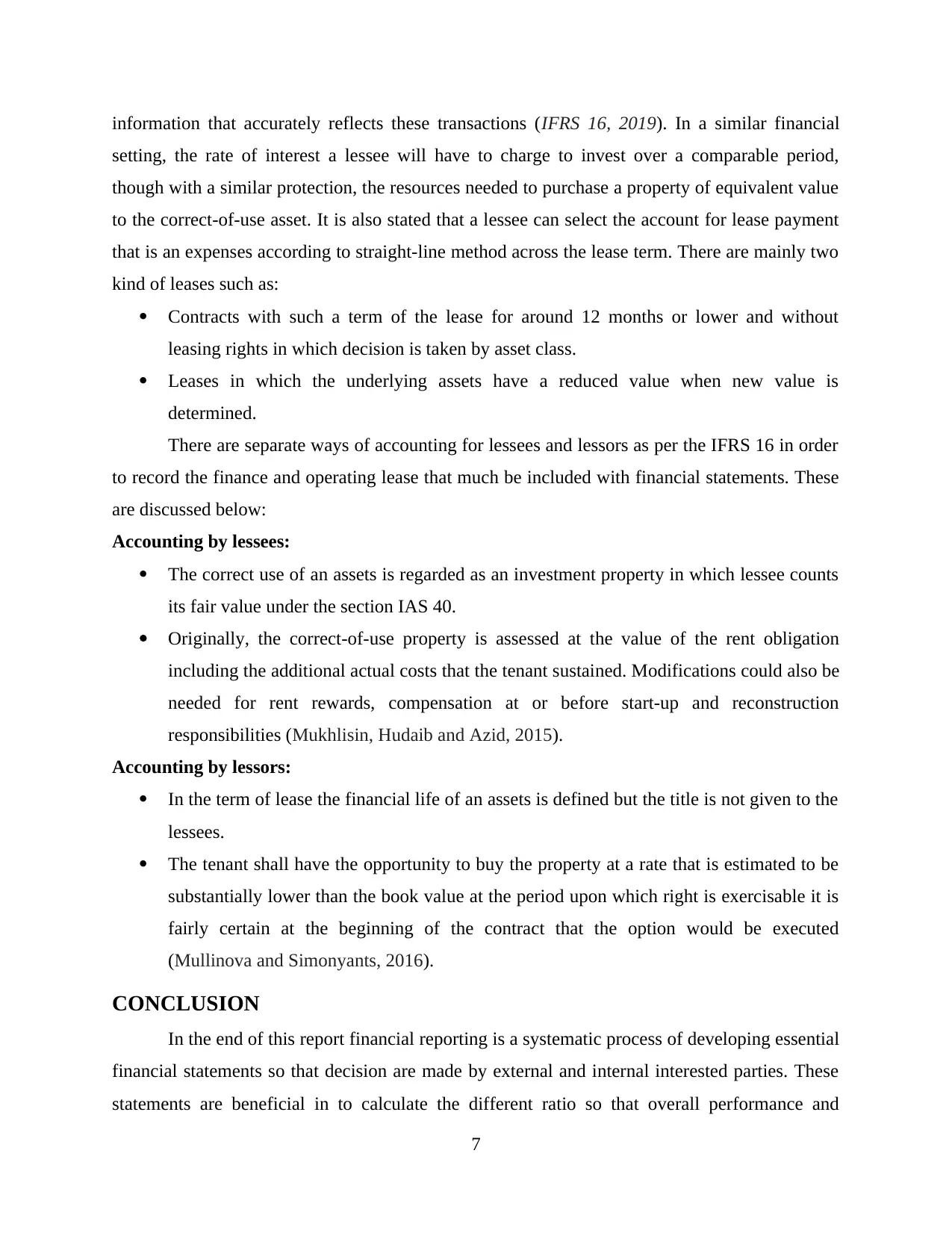
information that accurately reflects these transactions (IFRS 16, 2019). In a similar financial
setting, the rate of interest a lessee will have to charge to invest over a comparable period,
though with a similar protection, the resources needed to purchase a property of equivalent value
to the correct-of-use asset. It is also stated that a lessee can select the account for lease payment
that is an expenses according to straight-line method across the lease term. There are mainly two
kind of leases such as:
Contracts with such a term of the lease for around 12 months or lower and without
leasing rights in which decision is taken by asset class.
Leases in which the underlying assets have a reduced value when new value is
determined.
There are separate ways of accounting for lessees and lessors as per the IFRS 16 in order
to record the finance and operating lease that much be included with financial statements. These
are discussed below:
Accounting by lessees:
The correct use of an assets is regarded as an investment property in which lessee counts
its fair value under the section IAS 40.
Originally, the correct-of-use property is assessed at the value of the rent obligation
including the additional actual costs that the tenant sustained. Modifications could also be
needed for rent rewards, compensation at or before start-up and reconstruction
responsibilities (Mukhlisin, Hudaib and Azid, 2015).
Accounting by lessors:
In the term of lease the financial life of an assets is defined but the title is not given to the
lessees.
The tenant shall have the opportunity to buy the property at a rate that is estimated to be
substantially lower than the book value at the period upon which right is exercisable it is
fairly certain at the beginning of the contract that the option would be executed
(Mullinova and Simonyants, 2016).
CONCLUSION
In the end of this report financial reporting is a systematic process of developing essential
financial statements so that decision are made by external and internal interested parties. These
statements are beneficial in to calculate the different ratio so that overall performance and
7
setting, the rate of interest a lessee will have to charge to invest over a comparable period,
though with a similar protection, the resources needed to purchase a property of equivalent value
to the correct-of-use asset. It is also stated that a lessee can select the account for lease payment
that is an expenses according to straight-line method across the lease term. There are mainly two
kind of leases such as:
Contracts with such a term of the lease for around 12 months or lower and without
leasing rights in which decision is taken by asset class.
Leases in which the underlying assets have a reduced value when new value is
determined.
There are separate ways of accounting for lessees and lessors as per the IFRS 16 in order
to record the finance and operating lease that much be included with financial statements. These
are discussed below:
Accounting by lessees:
The correct use of an assets is regarded as an investment property in which lessee counts
its fair value under the section IAS 40.
Originally, the correct-of-use property is assessed at the value of the rent obligation
including the additional actual costs that the tenant sustained. Modifications could also be
needed for rent rewards, compensation at or before start-up and reconstruction
responsibilities (Mukhlisin, Hudaib and Azid, 2015).
Accounting by lessors:
In the term of lease the financial life of an assets is defined but the title is not given to the
lessees.
The tenant shall have the opportunity to buy the property at a rate that is estimated to be
substantially lower than the book value at the period upon which right is exercisable it is
fairly certain at the beginning of the contract that the option would be executed
(Mullinova and Simonyants, 2016).
CONCLUSION
In the end of this report financial reporting is a systematic process of developing essential
financial statements so that decision are made by external and internal interested parties. These
statements are beneficial in to calculate the different ratio so that overall performance and
7
⊘ This is a preview!⊘
Do you want full access?
Subscribe today to unlock all pages.

Trusted by 1+ million students worldwide
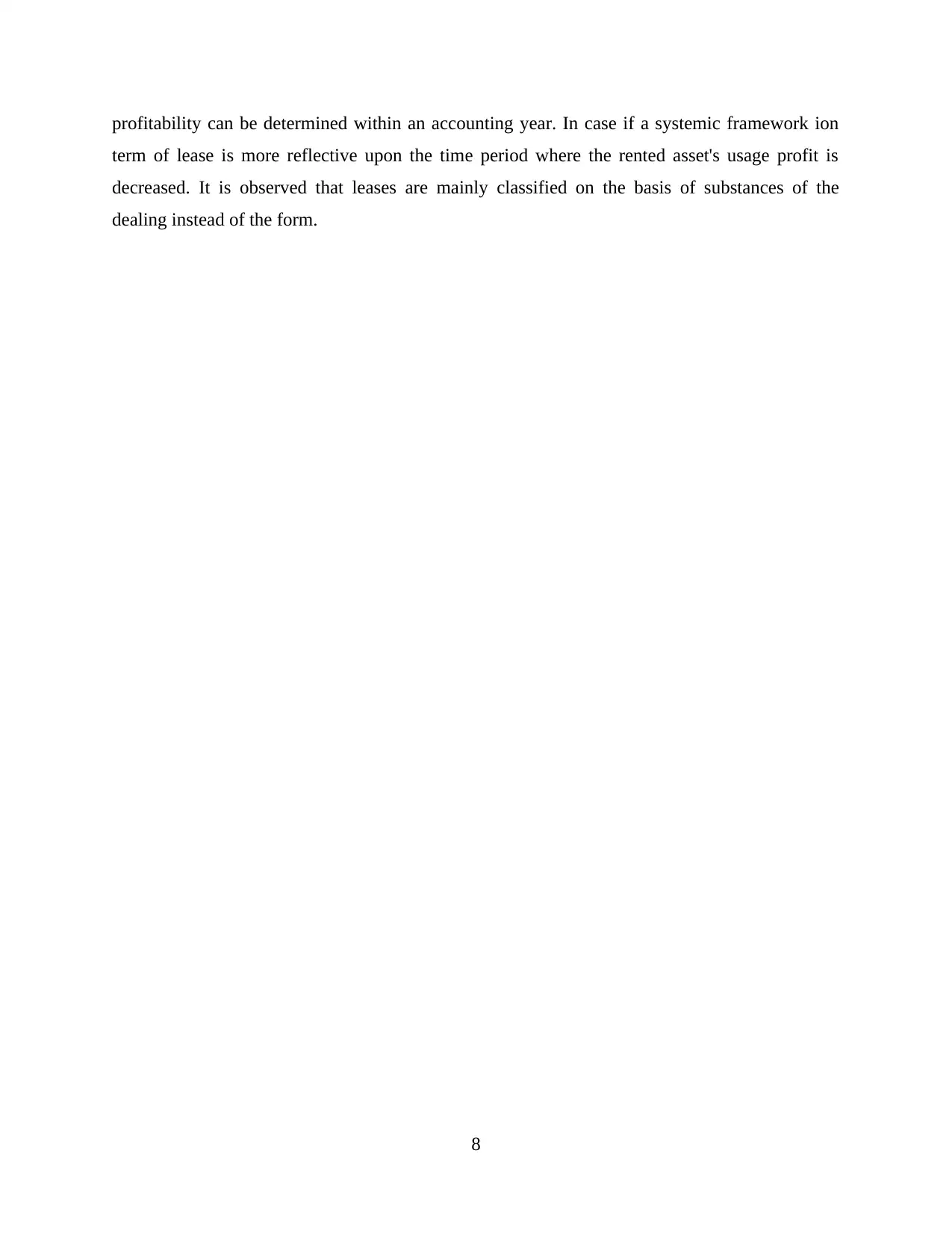
profitability can be determined within an accounting year. In case if a systemic framework ion
term of lease is more reflective upon the time period where the rented asset's usage profit is
decreased. It is observed that leases are mainly classified on the basis of substances of the
dealing instead of the form.
8
term of lease is more reflective upon the time period where the rented asset's usage profit is
decreased. It is observed that leases are mainly classified on the basis of substances of the
dealing instead of the form.
8
Paraphrase This Document
Need a fresh take? Get an instant paraphrase of this document with our AI Paraphraser
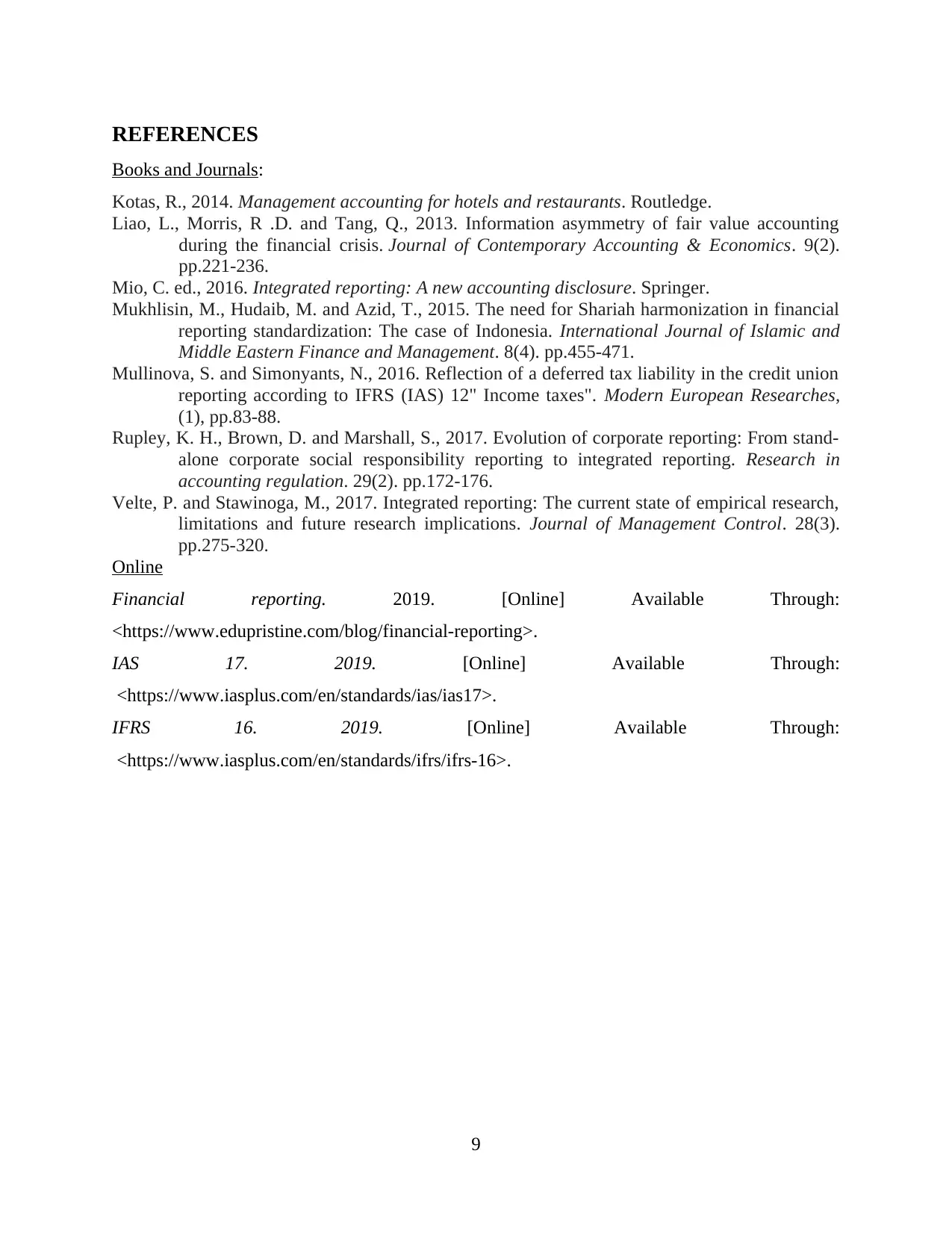
REFERENCES
Books and Journals:
Kotas, R., 2014. Management accounting for hotels and restaurants. Routledge.
Liao, L., Morris, R .D. and Tang, Q., 2013. Information asymmetry of fair value accounting
during the financial crisis. Journal of Contemporary Accounting & Economics. 9(2).
pp.221-236.
Mio, C. ed., 2016. Integrated reporting: A new accounting disclosure. Springer.
Mukhlisin, M., Hudaib, M. and Azid, T., 2015. The need for Shariah harmonization in financial
reporting standardization: The case of Indonesia. International Journal of Islamic and
Middle Eastern Finance and Management. 8(4). pp.455-471.
Mullinova, S. and Simonyants, N., 2016. Reflection of a deferred tax liability in the credit union
reporting according to IFRS (IAS) 12" Income taxes". Modern European Researches,
(1), pp.83-88.
Rupley, K. H., Brown, D. and Marshall, S., 2017. Evolution of corporate reporting: From stand-
alone corporate social responsibility reporting to integrated reporting. Research in
accounting regulation. 29(2). pp.172-176.
Velte, P. and Stawinoga, M., 2017. Integrated reporting: The current state of empirical research,
limitations and future research implications. Journal of Management Control. 28(3).
pp.275-320.
Online
Financial reporting. 2019. [Online] Available Through:
<https://www.edupristine.com/blog/financial-reporting>.
IAS 17. 2019. [Online] Available Through:
<https://www.iasplus.com/en/standards/ias/ias17>.
IFRS 16. 2019. [Online] Available Through:
<https://www.iasplus.com/en/standards/ifrs/ifrs-16>.
9
Books and Journals:
Kotas, R., 2014. Management accounting for hotels and restaurants. Routledge.
Liao, L., Morris, R .D. and Tang, Q., 2013. Information asymmetry of fair value accounting
during the financial crisis. Journal of Contemporary Accounting & Economics. 9(2).
pp.221-236.
Mio, C. ed., 2016. Integrated reporting: A new accounting disclosure. Springer.
Mukhlisin, M., Hudaib, M. and Azid, T., 2015. The need for Shariah harmonization in financial
reporting standardization: The case of Indonesia. International Journal of Islamic and
Middle Eastern Finance and Management. 8(4). pp.455-471.
Mullinova, S. and Simonyants, N., 2016. Reflection of a deferred tax liability in the credit union
reporting according to IFRS (IAS) 12" Income taxes". Modern European Researches,
(1), pp.83-88.
Rupley, K. H., Brown, D. and Marshall, S., 2017. Evolution of corporate reporting: From stand-
alone corporate social responsibility reporting to integrated reporting. Research in
accounting regulation. 29(2). pp.172-176.
Velte, P. and Stawinoga, M., 2017. Integrated reporting: The current state of empirical research,
limitations and future research implications. Journal of Management Control. 28(3).
pp.275-320.
Online
Financial reporting. 2019. [Online] Available Through:
<https://www.edupristine.com/blog/financial-reporting>.
IAS 17. 2019. [Online] Available Through:
<https://www.iasplus.com/en/standards/ias/ias17>.
IFRS 16. 2019. [Online] Available Through:
<https://www.iasplus.com/en/standards/ifrs/ifrs-16>.
9
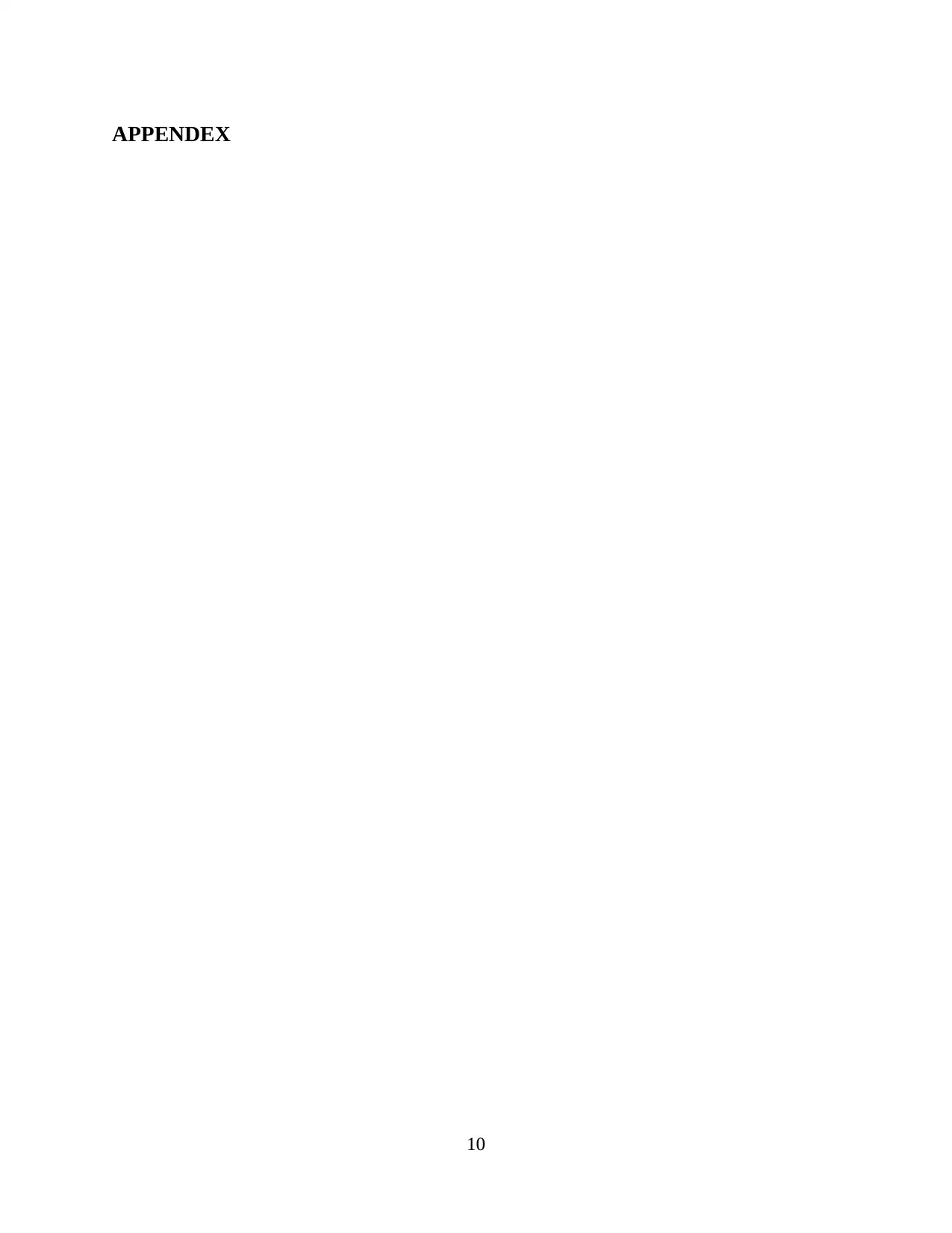
APPENDEX
10
10
⊘ This is a preview!⊘
Do you want full access?
Subscribe today to unlock all pages.

Trusted by 1+ million students worldwide
1 out of 14
Related Documents
Your All-in-One AI-Powered Toolkit for Academic Success.
+13062052269
info@desklib.com
Available 24*7 on WhatsApp / Email
![[object Object]](/_next/static/media/star-bottom.7253800d.svg)
Unlock your academic potential
Copyright © 2020–2025 A2Z Services. All Rights Reserved. Developed and managed by ZUCOL.




